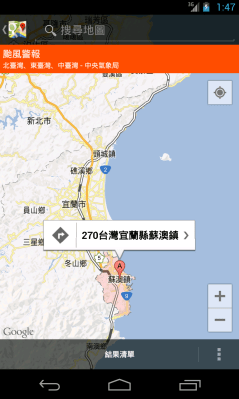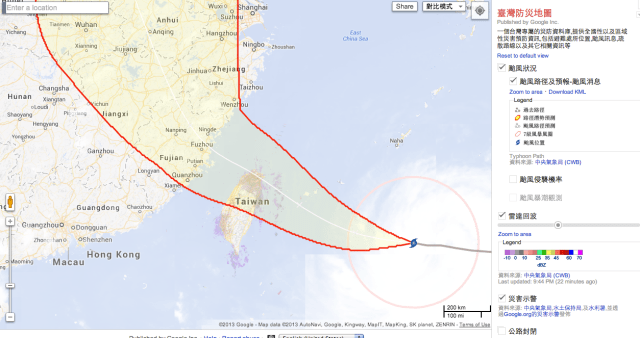Taiwan is bracing for Typhoon Soulik, which is scheduled to hit the island country late Friday. The arrival of the storm–now classified as a super typhoon–coincides with Google’s launch of Public Alerts for Taiwan yesterday. Severe weather alerts for typhoons and floods, and evacuation instructions if necessary, will appear on the page as well as on Google Search, Google Maps and Google Now on smartphones.
Google.org engineering director Eric Chu says the launch of Google Public Alerts for Taiwan just days before the anticipated arrival of Typhoon Soulik was a coincidence, as the company’s goal had been to make it available in time for typhoon season from mid-summer to early fall. Google.org’s goal is to encourage governments to adopt international standards of Web data such as the Common Alerting Protocol (CAP) for publishing and sharing alerts and the Keyhole Markup Language (KML) for geographic data.
After the 2011 earthquake and tsunami in Japan, the Google.org Crisis Response Team begin to look at the process of gathering and sharing data about natural disasters from official sources. A key challenge is that government agencies is often store information in closed formats like PDF files or JPEG images, making it difficult for researchers to share and analyze data.
Taiwan is the second Asian country after Japan to get Public Alerts, Google’s open data platform for emergency alerts and disaster information, which launched in the U.S. in January 2012 and is also available in Canada.
In 2009, residents of southern Taiwan were caught off-guard by the unexpected severity of Typhoon Morakot, which resulted in more than 500 deaths. The government was heavily criticized for its slow response, especially in rural areas where entire villages were swept away by landslides.
As a result, Taiwan’s Central Weather Bureau (CWB) promised to improve weather monitoring and the speed of forecasts. Chu says the CWB was instrumental in providing data for Google Public Alerts for Taiwan, which also draws on information from the Water Resource Agency, Soil and Water Conservation Bureau, the Directorate General of Highways and the Natural Science and Technology Center for Disaster Reduction. The cooperation of government agencies meant that work on Google Public Alerts for Taiwan was completed within nine months.
While Taiwan already had a system of SMS, radio and TV alerts in place–which are key for emergency notifications in rural areas with limited Internet access–Chu says using open data standards enables governments to quickly scale up disaster responses and relief coordination.
“Now we are reaching out to other countries to work with their data infrastructure so when a disaster hits, Public Alerts works without additional effort,” says Chu. “From our perspective, all the information is done so we are monitoring instead of having to scramble to figure out how to use and display the data.”

